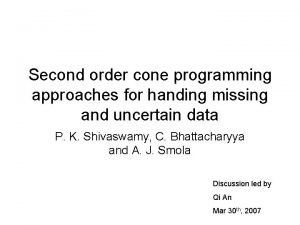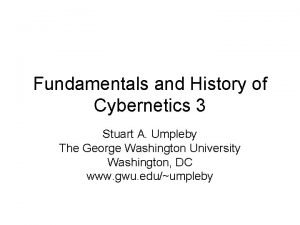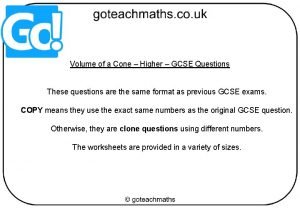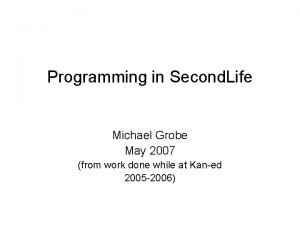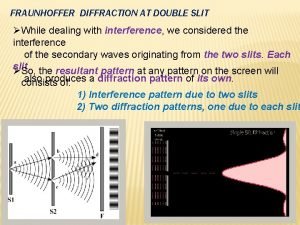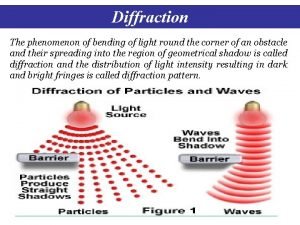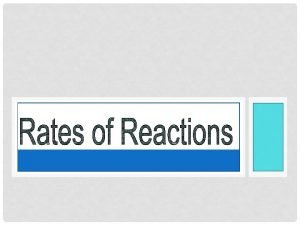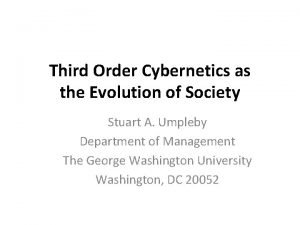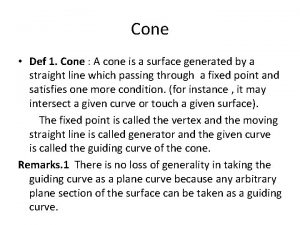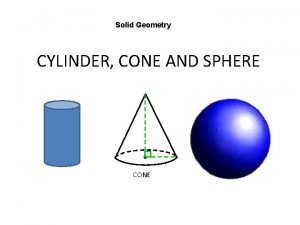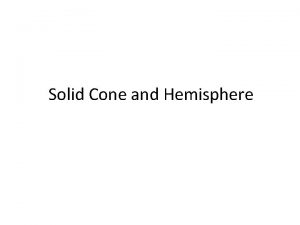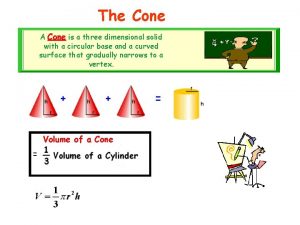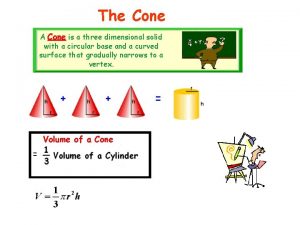Second order cone programming approaches for handing missing


















- Slides: 18

Second order cone programming approaches for handing missing and uncertain data P. K. Shivaswamy, C. Bhattacharyya and A. J. Smola Discussion led by Qi An Mar 30 th, 2007

Outline • • • Missing and uncertain Data problem Problem formulation Classification with uncertainty Extensions Experimental results Conclusions

Missing data problem • Consider a problem of classification or regression with missing data (only in feature). – Traditional method: simple imputation – Proposed method: robust estimation • Formulate the classification or regression problem into an optimization problem as long as we have information on the first and second moments of data

Classification problem with missing data • Compute the sample mean and covariance for each classes (binary here) from the available observations • Impute the missing data with their conditional mean. • The classification problem can be alternatively formulated into an optimization problem, as shown in the next slide.

Classification problem with missing data Suppose we are given n data points. First c points have complete feature vectors and last (n-c) points have feature vectors with missing values. First, Compute the sample mean and covariance for each classes (binary here) from the available observations Then, for any data vector with missing values, we can find the imputed means and covariances Given decomposed sample mean and sample covariance

Then the classification problem is equivalent to

Once we finish estimating the weights, w and b, from the dataset, we can make the prediction for any new data vector 1, If x has no missing values, go to 4 2, if x has missing values, fill the missing values xm using the parameters of each class to get two imputed data x+ and x 3, Find the distance of imputed data from hyper-plane, d+ and d-, and choose the imputed sample with higher distance 4, classify the data using sgn(w’x+b)

Classification with certainty (SVM) Linear separable -1 +1 Classification problem can be solved by solving this optimization problem

Classification with certainty (SVM) Linear non-separable -1 Two equivalent formulations: +1 second order cone constraint These two formulations are equivalent by choosing suitable C and W

Classification with uncertainty • Here, uncertainty means that for each pair (xi, yi) we only have a distribution over xi instead of a value for xi. As a result, xi is a random variable. • In this case, we rewrite the constraint in a probabilistic form In other words, we require that the random variable xi lies on the correct side of the decision hyper-plane with some probability greater than a pre-set threshold κi

Robust formulation Normal formulation If we assume each xi has mean and variance Σi. We want to be able to classify correctly even for the worst distribution in this class. The previous constraint becomes If we assume each xi has mean and variance Σi and follows a normal distribution. This should allow us to provide tighter bounds, as we have perfect knowledge on how xi is distributed The previous constraint becomes It can be proven that both of these two formulations lead to the same optimization problem by using multivariate Chebyshev inequality, which is summarized in Theory 1.

This optimization problem can be solved efficiently using various optimization methods

Geometric interpretation of constraint • Constraint 10(b) can be interpreted in a geometric way – If we assume x takes value in an ellipsoid – The robustness constraint 10(b) is equivalent to the geometric constraint below

Error measure • When classifying a point – Worst case error – Expected error

Extensions • The optimization problem can be extended – Regression problem – Multi-classification/regression – Some different constraints – Kernelized formulation Go back to the missing feature problem

Experiments • In a OCR data reorganization problem, compare SVM with simple imputation and proposed approach Some samples were misclassified by SVM but were correctly classified by the robust classifier

Ionospere regression problem

Conclusions • This paper propose a second order cone programming formulation for designing robust linear prediction function. • This approach is capable of tackling uncertainty in the data vectors both in classification and regression setting • It is applicable to any uncertainty distribution provided the first two moments are computable
 Second order cone programming python
Second order cone programming python Taking over navigational watch
Taking over navigational watch First order second order change
First order second order change First order cybernetics and second order cybernetics
First order cybernetics and second order cybernetics A cone has a volume of 98cm3 the radius of the cone is 5.13
A cone has a volume of 98cm3 the radius of the cone is 5.13 Bunsen burner steps
Bunsen burner steps Via optica
Via optica 27 miles per gallon into kilometers per liter
27 miles per gallon into kilometers per liter Lsl texture animation
Lsl texture animation Missing order in diffraction
Missing order in diffraction Difference between fresnel and fraunhofer diffraction
Difference between fresnel and fraunhofer diffraction Missing order in diffraction
Missing order in diffraction Perbedaan linear programming dan integer programming
Perbedaan linear programming dan integer programming Greedy programming vs dynamic programming
Greedy programming vs dynamic programming System programming vs application programming
System programming vs application programming Linear vs integer programming
Linear vs integer programming Definisi linear
Definisi linear Second order integrated rate law
Second order integrated rate law Second order cybernetics family therapy
Second order cybernetics family therapy
